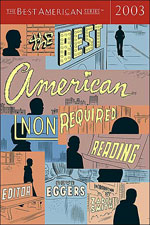[Transcribed discussion of “Welcome to Your Life and Congratulations,” by Ramona Ausubel, published in Green Mountains Review.
In the opening paragraphs of this story, the narrator—a young boy—watches his cat Houdini get hit by a car. The narrator, his parents, and a weird friend named Belbog debate whether to resuscitate the animal. In the end, they decide the cat is too old. Next they debate how to dispose of the cat, and the boy is angry with his parents for not being more heartbroken about his dead pet. Callously, his mother and father tell him this is just how life goes: “Welcome to your life,” they tell their son. Eventually, the family cremates Houdini. In the final scene, the narrator bursts into the room where is parents are making love. He throws the cat’s ashes into the air, covering their sweaty bodies, shouting “Welcome to your life!”]
Chloe: This story was very weird and that’s why I liked it. It’s visceral. It’s entertaining and kind of disturbing. It grabbed me and I can’t totally explain why. I had a good gut reaction to it. The characters are really good, and not predictable. I thought the parents were hilarious.
Bora: It’s just so twisted. Which is a good thing in this case. I mean, while they’re deciding what to do with the cat’s body they put it in the freezer. Who does that? And I agree, the interaction between the boy and his parents is really funny.
Chloe: I think it’s the dialogue that makes it good. And Belbog. His dialogue is so random and weird. Like when he explains what his name means, on page 31, he says, “My name means White God, did you know?” And then he randomly jumps to selling lemonade: “I hope we will be friends. Perhaps this summer you can come and together we can sell beverages on the side of the road?”
Sophia: I think the short sentences are really effective. Like when the father just says “You’re hot,” or the mother says, “He’s frozen,” on page 30. The short sentences leave a lot to the imagination.
Roxie: I thought the ending was perfect. The imagery there was really cool. The way his parents are so bewildered, it’s great. You don’t know why exactly he’s throwing the ashes in the air. Is he sad? Is he angry? He says, “Houdini is dead! I love you and I hate you! Welcome to your life!” It’s so full of emotion.
Sophia: Yeah, it’s interesting to wonder if he threw the ashes on his parents to spite them or whether it was some form of celebration.
[The students were asked the significance of the cat’s name, Houdini.]
Chloe: It’s because the cat performs a disappearing act. The cat is never alive in the whole story. At the beginning of the story Houdini can’t be found. And at the end Houdini is just a cloud of dust. This piece reminds me of a zombie story.
Will: Actually, I thought Houdini was going to show up alive at the end.
Adrianne: What I liked about this story is how it’s told through the eyes of a child. Things that might seem obvious to us as older people are really exciting and strange to this young boy. It’s a good point of view for a story.
Subscribe to:
Post Comments (Atom)









No comments:
Post a Comment